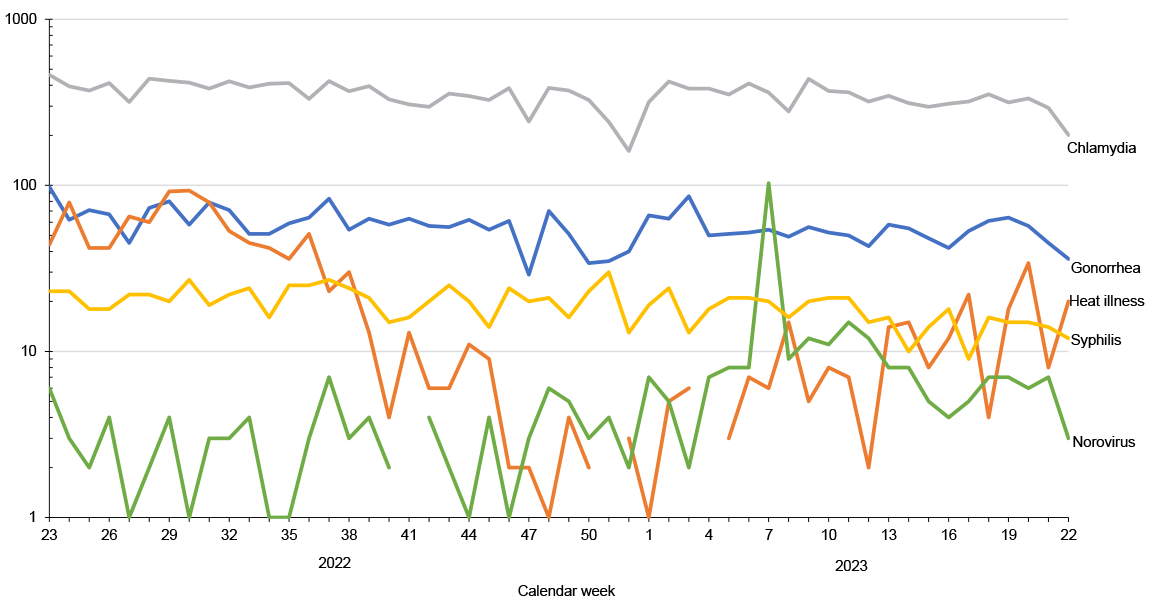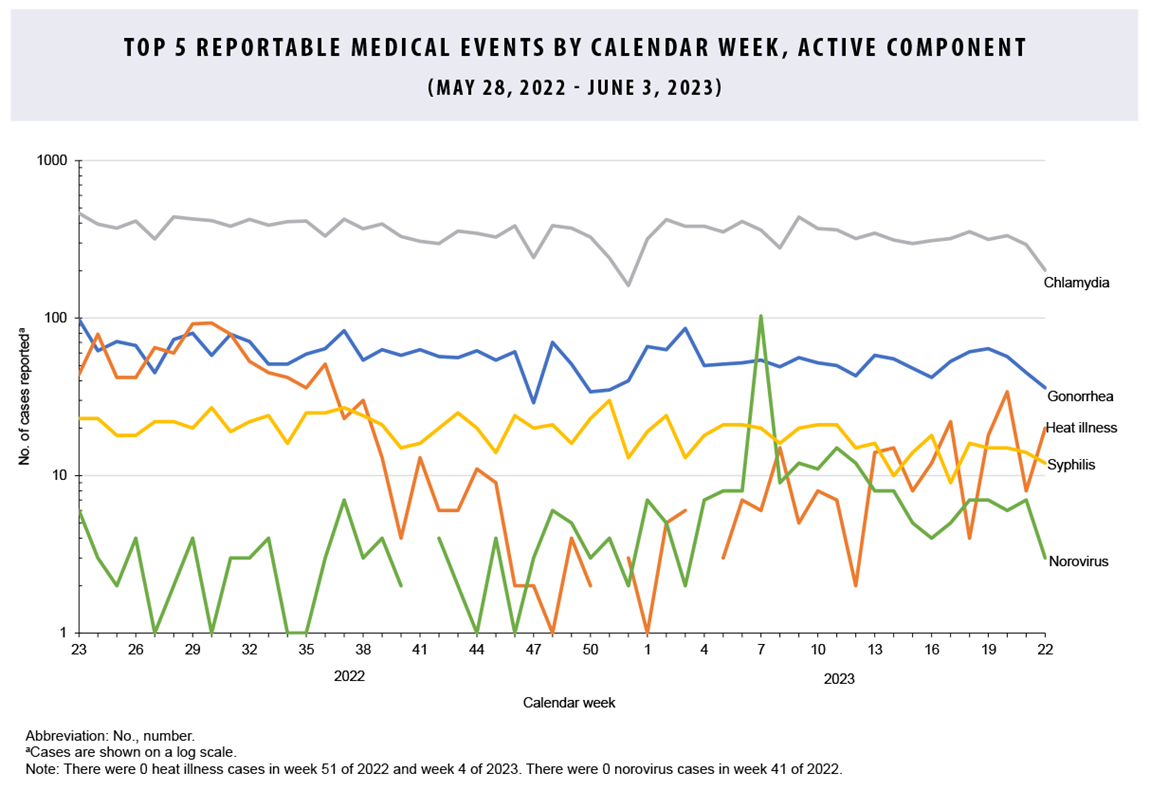Reportable Medical Events, Military Health System Facilities, Week 22, Ending June 3, 2023
 Graph depicting the frequency of the five most common reportable medical events within the Military Health System over the preceding year.
Graph depicting the frequency of the five most common reportable medical events within the Military Health System over the preceding year.
Reportable Medical Events are documented in the Disease Reporting System internet by health care providers and public health officials across the Military Health System for the purpose of monitoring, controlling, and preventing the occurrence and spread of diseases of public health interest or readiness importance. These reports are reviewed by each service’s public health surveillance hub. The DRSi collects reports on over 70 different RMEs, including infectious and non-infectious conditions, outbreak reports, STI risk surveys, and tuberculosis contact investigation reports. A complete list of RMEs is available in the 2022 Armed Forces Reportable Medical Events Guidelines and Case Definitions.1 Data reported in these tables are considered provisional and do not represent conclusive evidence until case reports are fully validated.

Total active component cases reported per week are displayed for the top five RMEs for the previous year. Each month, the graph is updated with the top five RMEs, and is presented with the current month’s (May 2023) top five RMEs, which may differ from previous months. COVID-19 is excluded from these graphs due to changes in reporting/case definition updates in 2023.

References
- Armed Forces Health Surveillance Division. Armed Forces Reportable Medical Events. Accessed April 6, 2023. https://www.health.mil/Military-Health-Topics/Health-Readiness/AFHSD/Reports-and-Publications/Armed-Forces-Reportable-Medical-Events
- Defense Manpower Data Center. Department of Defense Active Duty Military Personnel by Rank/Grade of Service, October 31, 2022. https://dwp.dmdc.osd.mil/dwp/app/dod-data-reports/workforce-reports
- Defense Manpower Data Center. Armed Forces Strength Figures for January 31, 2023. https://dwp.dmdc.osd.mil/dwp/app/dod-data-reports/workforce-reports
- Navy Medicine. Surveillance and Reporting Tools–DRSI: Disease Reporting System Internet. https://www.med.navy.mil/Navy-Marine-Corps-Public-Health-Center/Preventive-Medicine/Program-and-Policy-Support/Disease-Surveillance/DRSI
You also may be interested in...
Article
Jul 18, 2022
Tom Cruise has nothing on real military pilots and their training.
Article Around MHS
Jul 14, 2022
Army Garrison Fort Hunter Liggett’s remoteness, and the robust efforts of Fire Captain Devon Haggie allowed the installation to be the first in the Army and Department of Defense to receive the life-saving capability to transfuse whole blood by its Emergency Medical Service (EMS).
Article Around MHS
Jul 14, 2022
The USS Tripoli is operating in the U.S. 7th Fleet area of operations to enhance interoperability with allies and partners and serve as a ready response force to defend peace and maintain stability in the Indo-Pacific region.
Article Around MHS
Jul 11, 2022
The Utah Army National Guard Medical Detachment, the U.S. Army 30th Medical Brigade, and the Royal Moroccan Army collaborated to provide real-world humanitarian assistance to the local population here while simultaneously conducting medical readiness training during African Lion 2022.
Video
Jul 11, 2022
Learn more about Performance Nutrition and healthy eating habits at the Consortium for Health & Military Performance. https://champ.usuhs.edu/. For more information about the Dietician Approved Fueling stations at your local commissary, go to https://www.commissaries.com/fueling_stations
Video
Jul 11, 2022
Did you know that 75% of service members use at least 1 dietary supplement? Experts from the Uniformed Services University discuss the risks and safety concerns of dietary supplements. Learn more about dietary supplements at www.OPSS.org and The Consortium of Health & Military Performance (CHAMP).
Video
Jul 11, 2022
USU professor and nutrition specialist, Jonathan Scott PhD, gives advice on eating healthy. Learn more about the Dietician Approved Fueling stations at your local commissary here: https://www.commissaries.com/fueling_stations
Article Around MHS
Jul 8, 2022
Members of the Air Force's 137th Special Operations Medical Group (SOMDG) traveled to Azerbaijan to conduct a combat casualty care knowledge exchange with Azerbaijan Operational Capabilities Concept (OCC) Battalion doctors and medical noncommissioned officers during a State Partnership Program (SPP) visit to Baku, Azerbaijan in late June.
Article Around MHS
Jul 5, 2022
NMRTC Bremerton has formed a unique partnership to help ensure there’s a ready medical force capable of supporting fleet mission – and medical - readiness.
Article
Jul 5, 2022
Almost 60,000 people around the world die from rabies each year. Despite the common belief that rabid animals are easily identified by foaming at the mouth and aggressive behavior, infected animals may not look sick or act strangely.
Article Around MHS
Jul 1, 2022
Army Soldiers with the 547th Medical Company (Area Support), 56th Multifunctional Medical Battalion, 62nd Medical Brigade, participate in Crusader Challenge 2022.
Article
Jul 1, 2022
This report describes SARS-CoV-2 genomic surveillance conducted by the Department of Defense (DOD) Global Emerging Infections Surveillance Branch and the Next-Generation Sequencing and Bioinformatics Consortium (NGSBC) in response to the COVID-19 pandemic. Samples and sequence data were from SARS-CoV-2 infections occurring among Military Health System ...
Article
Jul 1, 2022
Lesbian, gay, and bisexual (LGB) individuals are at a particularly high risk for suicidal behavior in the general population of the United States. This study aims to determine if there are differences in the frequency of lifetime suicide ideation and suicide attempts between heterosexual, lesbian/gay, and bisexual service members in the active ...
Article
Jul 1, 2022
The Armed Forces Health Surveillance Division, as part of its surveillance mission, periodically conducts studies of cancer incidence among U.S. military service members. However, service members are likely lost to follow-up from the Department of Defense cancer registry and Military Health System data sets after leaving service and during periods of ...
Article
Jul 1, 2022
Respiratory pathogens, such as influenza and adenovirus, have been the main focus of the Department of Defense Global Respiratory Pathogen Surveillance Program (DoDGRPSP) since 1976.1. However, DoDGRPSP also began focusing on SARS-CoV-2 when COVID-19 was declared a pandemic illness in early March 2020.2. Following this declaration, the DOD quickly ...
You are leaving Health.mil
The appearance of hyperlinks does not constitute endorsement by the Department of Defense of non-U.S. Government sites or the information, products, or services contained therein. Although the Defense Health Agency may or may not use these sites as additional distribution channels for Department of Defense information, it does not exercise editorial control over all of the information that you may find at these locations. Such links are provided consistent with the stated purpose of this website.
You are leaving Health.mil
View the external links disclaimer.
Last Updated: August 24, 2023